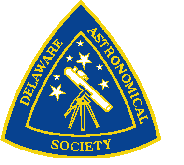

|
Don Shedrick |
|
|
|
|
|
Jan 8, 2002 |
January DAS Focus
COMPUTERS IN ASTRONOMY by Don Shedrick
With us all feeling perhaps a bit heavy after the holidays, I thought it appropriate to feature some "Lite" astronomy programs this month. These are programs that do not require any downloads of software and installation on your PC, but instead run directly off the Internet using a Java applet. These are becoming more common and their capabilities are ever increasing. If you have been timid about downloading software off the Internet, now is the time to try these easy programs. Be sure to go to the DAS web site to get the online version of this column, and save yourself some typing with all the hotlinks.
http://www.cis.udel.edu/~case/das.html
The Astronomy Calculator provides general information about the phases of the moon, the next lunar eclipse, next annual meteor shower and location and visibility of the planets. All functions were created using JavaScript. It can be run from the web site:
http://w3.one.net/~rback/frames.html
One only needs to input the Month, Day, and Year, along with your desired time of observation. The program returns the beginning new moon, first quarter, full moon, third quarter and the ending new moon for the period, and lists the date, maximum phase, and penumbral magnitude for the next lunar eclipse. In addition, a Calendar Button displays a lunar phase calendar for the given month and year. Another section lists the name, active period, peak date, rate per hour, right ascension, declination, and magnitude of the next major meteor shower. The last section lists the right ascension, declination, distance, size, and magnitude of the planets, and indicates if the planet is visible based on the input parameters.
NASA SkyWatch is a web-based Java application that provides sky watchers worldwide with a picture of when and where the International Space Station, the space shuttle and other spacecraft can be seen with the unaided eye as they pass overhead. This applet uses up-to-the-minute data from Mission Control to project the path the spacecraft will make across the sky. It includes a sky chart that shows the path of the spacecraft across the night sky. SkyWatch can be found at:
http://spaceflight.nasa.gov/realdata/sightings/SSapplications/Post/JavaSSOP/JavaSSOP.html
J-Track plots various satellites from a different perspective against a map of the earth - so you could quickly and easily keep track of your favorite orbiting objects. J-Track lets you choose from a fairly large list of satellites, and includes a 3-D version that animates satellite positions on a globe of the earth. It can be found on a section of the NASA Liftoff to Space Exploration web site:
http://liftoff.msfc.nasa.gov/realtime/JTrack/
The JupSat applet is featured on the Irish amateur astronomer Gary Nugents Skynotes page at:
http://indigo.ie/~gnugent/dnso/skynotes.htm
It displays a real-time side-on view of Jupiter and its satellites. Clicking on Jupiter or the satellite images takes you to a webpage dedicated to that object.
The Castle Point Astronomy Club is an active amateur astronomy club near Rayleigh, Essex, UK. Member Brendan Murphy has developed the Java application Planets. It is located on the web at:
http://www.cpac.freeserve.co.uk/docs/solar.htm
After entering your location, Planets displays the Moons of Jupiter and Saturn, display the orbits of the planets, has animation, and forecasts various planetary events, including Galilean satellite events for Jupiter.
Incase you get carried away with that long winters rest, you may need a good screen saver for your PC. What better way to protect your monitor's phosphors than by smashing rocks into it at dozens of kilometers per second? John Walker has created a Windows screen saver named Craters, which simulates cratering of initially flat terrain, obeying the same power-law relating crater size to number observed on airless solar system bodies. This freeware can be downloaded at:
http://www.fourmilab.ch/craters/
The Sky Screen Saver, also by John Walker, is based on his excellent Home Planet software program previously featured in this column. It shows the sky above any location on Earth, including stars (from the Yale Bright Star Catalogue of more than 9000 stars to the 7th magnitude), the Moon in its correct phase and position in the sky, and the position of the Sun and all the planets in the sky. This freeware can be downloaded at:
http://www.fourmilab.ch/skyscrsv/
The screen saver displays outlines, boundaries, and names of constellations, as well as names and Bayer/Flamsteed designations of stars brighter than a selected threshold. A database of more than 500 deep-sky objects, including all the Messier objects and bright NGC objects can be plotted to a selected magnitude. The ecliptic and celestial equator can be plotted, complete with co-ordinates. To be an effective screen saver, the sky map shifts position on the display every 10 minutes to avoid burning in those few components of the display which do not move as the Earth revolves.
John Walkers final screen saver, The Earth Screen Saver, is freeware and is available at:
http://www.fourmilab.ch/earthscr/
The Earth screen saver displays an image of the Earth as currently illuminated by the Sun, from a variety of viewpoints. You can view the Earth from the Sun (day side), the night side, from the Moon, or from an arbitrary altitude above any point on the globe specified by latitude and longitude. Day and night regions of the globe are shown based on the current date and time. The image of the Earth shifts location on the screen every 10 minutes to avoid burning in the phosphors in one location. The images of the Earth are generated based on a global topographic map developed by the Marine Geology and Geophysics Division of the National Geophysical Data Center operated by the United States Department of Commerce, National Oceanic and Atmospheric Administration